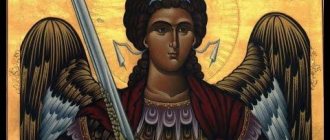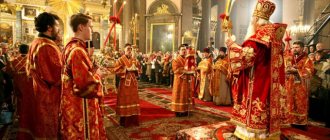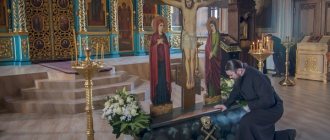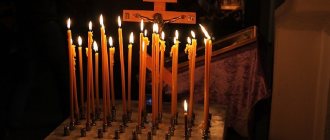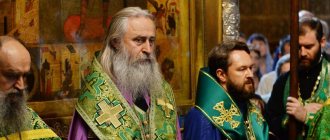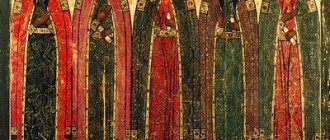Prayer and its meaning in Orthodoxy
The Orthodox tradition endows prayer with an important virtue - dispassion. Re-read the Gospel, which contains the important thought of the Son of God. This idea comes down to the removal of everything vain to the periphery of human consciousness.
While reading prayers, the following are expelled from the mind:
- fornication;
- theft;
- murders;
- any uncleanness.
Emotional outbursts interfere with awareness and a clear understanding of the role of the temple in our lives. A similar mistake was already made by the Corinthian Christians, who tried to pour out their feelings in several languages and engage in prophecy. The Apostle Paul called these people to prudence. The saint recommended reading prayer texts wisely, controlling your actions.
The importance of prayers in Orthodoxy is very great. Praises to the Lord are offered morning and evening, together and individually. When we sing together with the church choir or offer speeches of gratitude to the Father and the Son, we cleanse our inner beings and prepare to endure any trials with fortitude. Have you noticed that the deacon reads the holy texts measuredly? Such an activity does not tolerate fuss, excessive enthusiasm or shedding of tears. The Lord gave you intelligence, use it.
Joint prayers in the temple
In churches, communal prayer is given special importance. The Church is not a gathering of lonely believers, it is a single organism acting in a common spiritual impulse. Joint prayer is an instrument of unity with God, which is invisibly present in any church.
Remember that there are church sacraments that only a clergyman can perform. Such sacraments are not limited to the reading of prayers.
Common prayer is most relevant during great services. Believers worship not only Jesus Christ, but also the Mother of God, as well as famous saints who made a significant contribution to the development of Christianity. If one of the parishioners is distracted from the service, the rest continue to pray. And this is where the power of collective hymns to the Mother of God and other saints lies.
Here are the main points in church services that are worth paying attention to:
- Praises to the Holy Spirit are offered by the priest and deacon (the second acts as an assistant).
- The prayer is said by specially trained people - readers.
- Singing is also present in the Orthodox tradition.
- If the Mother of God is glorified in words that are not entirely clear to you, be patient and attentive. Soon the meaning will dawn on you.
- It's okay to sing along with the choir, just try not to disturb the rest of the congregation.
- A lay rite is also known - the service of the daily circle (here the participation of a priest is not required).
Liturgical prayers
There are two types of prayer actions. The first includes services conducted inside churches only by clergy. The prayer that parishioners read with their pastor is one of the joint services. The text should be pronounced without errors, so try to learn it by heart. Among such prayers it is worth noting:
- "Our Father…";
- Symbol of faith;
- appeal to the sacrament verse;
- song about the Resurrection of Christ;
- exclamations at services during Easter.
The category of liturgical prayers includes troparia, stichera and kontakion. Similar texts can be read at home, but it is better to do this by joining the believers in the temple.
Do you know what prayers only a priest does? Here is their list:
- lighting;
- for the implementation of requirements or sacraments;
- Ephraim the Syrian;
- Eucharistic.
The Importance of Temple Service
You can pray to the Mother of God at home - then you won’t have to wait for the end of the service. So why are so many believers interested in joint prayers?
Icon "King of Glory".
It’s simple - the Lord views the Church as a single organism. Jesus and the Mother of God commanded us to love our neighbors, and our neighbors gather in church. Prayer brings Orthodox Christians together and puts them in a common mood. In addition, joint aspirations make the service more effective.
Spiritual guides recommend keeping track of time, since the devil tempts us with the illusion of “excessive length” of services. On average, we pray no more than 8-10 minutes daily. Some glorify the Mother of God, some glorify the patron saint. It is important to keep these actions under control, even if you go to church service.
Here are some more reasons why you should be in the temple:
- A feeling of unity with God and other people.
- Opportunity to communicate with the priest and other parishioners (after the service ends).
- Proximity to sacred relics.
- Nice calming atmosphere.
Order of services
Joint prayer in the temple is read according to the schedule, at a strictly allotted time. The church charter regulates the service. There are many prayers in churches and monasteries, and they are read daily.
A day in the temple is divided into three parts:
- Morning service.
- Divine Liturgy (main part).
- Evening service (the one that begins around 18.00-19.00).
It is worth noting that there are no clear chronological boundaries for the services. It all depends on the current time of day, but the duration of the event is not limited by the canons. Therefore, you should not ask parishioners about the ends of services - you will not receive clear answers. Better think about the Mother of God or the sacrifice of Jesus, who suffered for our sins - that’s who really knew how to endure. If you want to imagine the approximate boundaries of services, then aim for one and a half to two hours. In some cases, prayer can last for three hours.
Once in the temple, you must distinguish between annual, weekly and daily services. In all cases, the priests read the prayer to the same Mother of God repeatedly. The daily services are closed in a ring throughout the day, and a similar picture is repeated with the weekly and annual cycles. In daily activities there is a basic framework, a regulated order of actions. Other rituals are not strictly specified.
When interested in prayers, pay attention to the following details:
- Daily circle. Events from the biography of the Savior correspond to each hour of the cycle. As you approach the temple, you should have at least some understanding of the life of Jesus. It is also worth taking an interest in the Virgin Mary.
- Weekly circle. Here the Sacred History is connected with certain days of the week, and this connection is reflected in every prayer read.
- Annual circle. Here it is worth considering not only the life of Jesus himself, but also the biographies of his companions (apostles), as well as saints. The Mother of God also plays an important role. Each event is associated with a specific day of the year.
When interested in an Orthodox church, keep in mind an important detail - there is the concept of a liturgical day.
Any prayer begins to be said in the evening - this order is called the evening service. The next stage is Matins, after which it is time for the Divine Liturgy. On Sundays and holidays, all components come together, and parishioners participate in an all-night vigil.
Particular attention should be paid to the Liturgy, within which one of the key Orthodox sacraments is celebrated - the Eucharist. Here the matter is not limited to prayer, since the priest organizes a complex ritual filled with deep symbolism. We are talking about Communion. Believers eat bread and wine - these products are associated with the flesh and blood of the Savior.
Eucharist. Sacrament of Communion.
There are three main components in the Liturgy:
- Proskomedia (The Holy Gifts must be prepared for consecration).
- Liturgy of the Catechumens (at this stage, psalms are sung, people praise Jesus and the Mother of God, excerpts from Scripture are read, deceased relatives are remembered with prayers).
- Liturgy of the Faithful (Gifts are consecrated, the sacrament itself occurs, the faithful receive communion).
Prayers for the service
The Eucharistic Prayer occupies an important place in the Liturgy. The text, called the anaphora, is pronounced by the priest over the Gifts - this is done secretly within the altar. Modern churches do not allow us to completely hide what is happening, so some of the minister’s cries reach the ears of the parishioners. At the very beginning of the action, the light is lit, and at the end of the sacrament the candles must be extinguished.
Preparing for Anaphora
It is worth noting that there are a lot of prayers in Orthodoxy, and the list of their texts can be endless. Believers bow before the Mother of God, the apostles and significant figures of the saints. Thus, at the all-night vigil the following texts are read (only a few are given):
- "The Ninth Hour";
- "Small Vespers";
- "Great Litany";
- "Lithia";
- "Blessing of the Loaves"
Morning prayer also has its own characteristics. The Mother of God, Jesus, or one of the apostles may be glorified here, but there is a certain set of texts that cannot be avoided. Here are just some examples:
- “Six Psalms”;
- "Great Litany";
- "Every breath";
- "Resurrection of Christ";
- "Canon".
In addition to all of the above, morning services include stichera and excerpts from the troparion. Now and forever there will be a prayer “End of Matins”, known as the “Great Dismissal”. In addition, kontakia are used for the first hour of prayer.
How does the service end?
After supper, the glorification of Jesus and the Mother of God, Compline is celebrated in Orthodox churches. The essence of this event comes down to public prayer activities that remind the congregation of Jesus' descent into hell. It is important to remember here that man has been freed from the power of Satan and must now honor the Lord.
With the onset of midnight, the so-called Polunnoshnitsa begins - the third divine service of the daily cycle. But Matins is served just before dawn and smoothly flows into the hours, of which there are six. All of these processes have a strict sequence and their own endings. To understand the nuances, attend church, read spiritual literature and talk with priests.
How to behave at the liturgy
Liturgy is not an ordinary divine service, but a sacrament, that is, a sacred act in which the believers are given the sanctifying grace of the Holy Spirit.
At this special service, prayers and chants are offered to God, and the mysterious Bloodless Sacrifice is offered for the salvation of people. Under the guise of bread and wine, the true Body and true Blood of our Lord Jesus Christ is taught to the Orthodox. This is why the liturgy takes precedence over other services.
At the Divine Liturgy, or Eucharist, the entire earthly life of our Lord Jesus Christ is remembered.
Conventionally, the liturgy is divided into three parts: proskomedia, liturgy of the catechumens and liturgy of the faithful.
Proskomedia Proskomedia
At the proskomedia, living and deceased members of the Church are remembered. People who order proskomedia hand over notes with names and prosphora purchased at the church shop to the altar. The priest pulls particles from the prosphora and remembers the health or peace of those served. Only the names of baptized people receiving communion can be submitted to the proskomedia.
Great joy comes to the souls of the departed from their commemoration at the Proskomedia.
At the end of the proskomedia, the priest censes the entire temple.
At this time, the reader finishes reading the clock. The Liturgy of the Catechumens begins. Liturgy of the Catechumens Catechumens
Next, we will look at how to behave at the Liturgy of the Catechumens.
1. The Liturgy of the Catechumens begins with the words: “Blessed is the Kingdom, always, now and ever, and unto ages of ages.” The choir sings: "Amen." We sign ourselves with the sign of the cross.
2. The great litany begins. Litany are special petitions pronounced by the clergyman, to which the choir responds by singing: “ Lord, have mercy . At each litany of petitions pronounced, one must be baptized.
3. At the end of the litany, the choir begins to sing the so-called pictorial antiphons. There are only three of them, in honor of the Holy Trinity. They are sung in succession and separated from each other by small litanies.
4. After the second figurative antiphon, the choir sings a song to the Lord Jesus Christ: “Only Begotten Son...” , in which we hear about the incarnation of God into man in order to save people from sin.
5. Small litany - we are baptized at each petition.
6. And the third antiphon is sung, which begins with the words of the thief crucified with the Lord on the cross: “In Thy Kingdom, remember us, O Lord...” . You need to listen carefully to this chant. It has a deep meaning. After all, we remember that Jesus Christ said to this thief: “Truly I tell you, today you will be with Me in Paradise . The third antiphon is certain commandments, by obeying which a person will come to the Kingdom of Heaven.
7. During the singing of the third antiphon, the small entrance is made. The clergy leave the altar carrying a candle, censer and the Gospel. This action symbolizes the procession of the Lord with a host of angels.
8. After entering, troparia and kontakia are sung, which reflect the sacred events of the holiday. We cross ourselves at every song.
9. Next, the angelic song “Holy God, Holy Mighty, Holy Immortal, have mercy on us” . At every singing we sign ourselves with the sign of the cross.
At this time, the priest in secret prayer asks the Heavenly Father to accept the Trisagion and forgive our sins, voluntary and involuntary.
10. The following is the reading of the Apostle. This is a book that contains the acts and messages of the holy apostles to certain nations. During the reading of the Apostle, the deacon censes; one must respond to his censing by bowing his head.
11. After reading the Apostle, the choir sings “Alleluia” three times. We cross ourselves three times with bows.
12. The priest proclaims: “Wisdom, forgive me, let us hear the Holy Gospel. Peace to all” - you need to bow your head to receive the blessing.
13. While reading the Gospel, as if listening to the Lord Jesus Christ Himself, you should stand with your head bowed.
14. After reading the Gospel, the litany follows: “Pray for the announcement of the Lord... Verily, let us pray for the catechumens, that the Lord may have mercy on them... He will announce them with the word of truth... He will reveal to them the Gospel of truth...” - as we see, the petitions are connected with the catechumens, people who are not yet in the bosom of the church, that is, not baptized, or under prohibition, penance.
15. At the second litany, the priest proclaims: “Elitsa, catechumens, come out, catechumens, come out, let none of the catechumens return, again and again, let us pray to the Lord in peace .
From these words it is clear that the catechumens need to leave the church before the end of the liturgy. This is explained by the fact that a person unrepentant of sins or not belonging to the faithful of the church (baptized) cannot attend the Eucharist. The Eucharist is the greatest sacrament of the church, when wine and bread are transformed into the Body and Blood of our Lord Jesus Christ. In the Sacrament of Communion, all faithful children are united with Christ. Liturgy of the Faithful Let us examine
Faithful Christians constitute the Church of Christ and only they can concelebrate with the priest in the sacrament of the Eucharist.
1. At the end of the litanies, the Cherubic Hymn is sung.
If we translate it from Church Slavonic into Russian, it means the following: “We, mysteriously depicting the cherubim and singing the Trisagion hymn to the Trinity, which gives life, will now leave the concern for all everyday things, so that we can glorify the King of all, Who is invisibly carried and glorified by the angelic powers .
This prayer reminds us how the angelic forces in heaven serve at the throne of God and is based on the visions of the prophets Isaiah, Ezekiel.
Concluding the above, how to behave during the Cherubic Song? The answer is simple! The way they would behave if they were before the Throne of God.
Also, while singing the Cherubic Song, it is recommended to mentally read Psalm 50: “Have mercy on me, O God, according to Your great mercy...” . It can be found in the prayer book.
2. The Great Entrance is when the clergy leave the altar carrying the Cup of wine and paten (special liturgical utensils) with the Lamb. They stand on the pulpit and commemorate the Patriarch, the diocesan bishop, all the benefactors present in the church and praying, all Orthodox Christians. This is done in order to show that the Holy Gifts will be sacrificed to God for the salvation of all those remembered.
The Great Entrance symbolizes the procession of the Lord Jesus Christ to free suffering for the salvation of the world.
3. This is followed by a litany of petition, in which the priest prays for the Gifts transferred to the throne, for the granting of saving benefits to all who ask. (we make the sign of the cross at every petition that is proclaimed).
4. The deacon proclaims: “Doors, doors, let us sing of wisdom . The words “Doors, doors” in ancient times referred to the gatekeepers, so that they would not allow catechumens or pagans into the temple during the sacrament of the Holy Eucharist. The words: Let us listen to wisdom (let us heed) call the attention of believers to the saving teaching of the Orthodox Church, set out in the Creed.
5. The choir sings the Creed. At the beginning of the Creed, the sign of the cross should be made.
The Creed was compiled by the will of the Holy Spirit by the Holy Fathers of the 1st and 2nd Ecumenical Councils. It is an unchanging guide for all Orthodox Christians in their spiritual life.
The Creed is a summary of our faith.
“I Believe” is allowed to be sung with the choir.
6. The deacon or priest proclaims: “Let us become kind, let us become fearful, let us bring holy offerings to the world . These words call on believers to gather their spirit and mind before the upcoming sacred rite.
The Eucharistic canon begins. The choir sings the song “The Grace of the World...” .
3. Why do you need to behave collectedly during this chant? Because, when singing the words “We sing to You, we bless You, we thank You...” the greatest mystery is accomplished - the priest asks God to send the Holy Spirit on those praying and the Gifts. The descent of the Holy Spirit on the Gifts transforms them into the Body and Blood of our Lord Jesus Christ. During the Holy Eucharist one must pray with special attention. The importance of this minute is so great that not a single minute of our life can compare with it. In this sacred moment lies all our salvation and God’s love for the human race, for God appeared in the flesh.
4. While singing It is Worthy to Eat (or another sacred song in honor of the Mother of God - the worthy one), the priest prays for the living and the dead, remembering them by name, especially those for whom the Divine Liturgy is performed. And those present in the temple should at this time remember by name their loved ones, living and dead.
5. After it is worthy to eat or the worthy person replacing it - bow to the ground. At the words: And everyone, and everything, a bow is made from the waist.
6. At the beginning of the nationwide singing of the Lord’s Prayer—Our Father—one should make the sign of the cross and bow to the ground.
7. When the priest exclaims: “Holy to the holy,” prostration is required for the sake of lifting up the Holy Lamb before His fragmentation. At this time, we must remember the Last Supper and the last conversation of the Lord Jesus Christ with the disciples, His suffering on the cross, death and burial.
8. Upon the opening of the royal doors and the presentation of the Holy Gifts, signifying the appearance of the Lord Jesus Christ after the Resurrection, with the exclamation: “Come with the fear of God and faith!” - a bow to the ground is required.
9. When starting to receive the Holy Mysteries of the Body and Blood of Christ after the priest reads the prayers before communion, one must bow to the ground, fold his arms crosswise on his chest (under no circumstances cross himself, so as not to accidentally push and spill the Holy Chalice - folded hands at this time replace the sign of the cross) and slowly, reverently, with the fear of God, approach the Holy Chalice, calling your name, and after receiving the Holy Mysteries, kiss the lower part of the Chalice, like the most pure rib of Christ, and then step aside calmly , without making the sign of the cross and bowing before receiving warmth. We must especially thank the Lord for His great mercy, for the gracious gift of Holy Communion: Glory to Thee, God! Glory to You, God! Glory to You, God! Prostrations to the ground on this day are not performed by the communicants until the evening. Those who do not receive communion at the Divine Liturgy, during the holy moments of communion, should stand in the church with reverent prayer, without thinking about earthly things, without leaving the church at this time, so as not to offend the Shrine of the Lord and not to violate the decorum of the church.
10. At the words of the priest: “Always, now and ever and unto ages of ages ,” at the last manifestation of the Holy Gifts, depicting the Ascension of the Lord Jesus Christ to Heaven, a prostration with the sign of the cross is required for those who have not been honored with the Holy Mysteries, but for those who partake - bow from the waist with the sign of the cross. Those who have not yet had time to receive warmth by this time should turn their face to the Holy Chalice, thereby expressing reverence for the great Shrine.
11. The Holy Antidoron (from Greek - instead of a gift) is distributed to those present after the Divine Liturgy to bless and sanctify the soul and body, so that those who have not partaken of the Holy Mysteries may taste the consecrated bread. The Church Charter indicates that antidor can only be taken on an empty stomach - without eating or drinking anything.
The antidorus should be received reverently, folding your palms crosswise, right over left, and kissing the hand of the priest giving this gift.
12. At the end of the liturgy, the priest remembers the names of the saints whose memory is celebrated on this day and the creator of the liturgy (for example, John Chrysostom, who wrote the liturgy called the Liturgy of John Chrysostom).
The choir sings for many years, where the patriarch, diocesan bishop, parishioners of the temple and all Orthodox Christians are remembered.
13. All those praying approach the Cross, which the priest gives to kiss.
If you find an error, please select a piece of text and press Ctrl+Enter.

